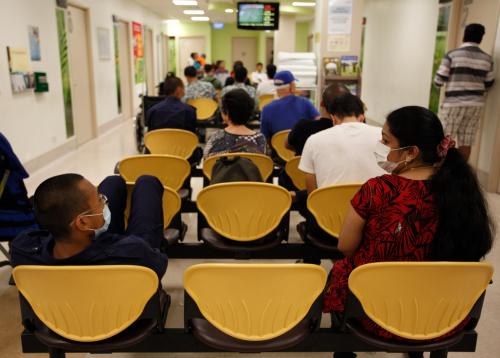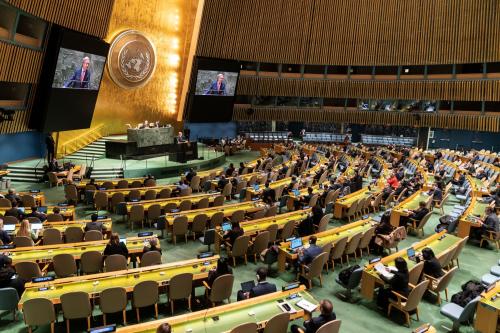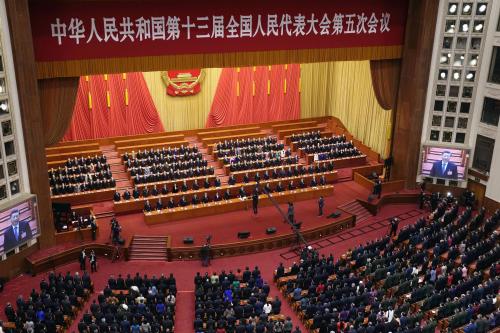This article was first published in Issue 9, June 2011 of ETHOS, a journal of the Civil Service College Singapore. For more information, please visit http://www.cscollege.gov.sg/ethos.
An important achievement of the capitalist democracies is the creation of policies and programmes that put a human face on capitalism.[1] To use a word popular in Europe, these nations have found ways to balance capitalism with solidarity. Solidarity is the principle that the people of a nation, often operating through their government, accept some responsibility for helping fellow citizens (and even non-citizens) avoid destitution and enjoy some of the fruits of modern economies. There are substantial differences across the capitalist democracies in both the nature and the impacts of their solidarity programmes, but they all provide public help for the elderly, the unemployed, the sick or disabled, and the destitute.[2] These four groups are at risk of poverty or worse because their ability to work and support themselves and their families is impeded by age, infirmity, or difficulty finding a job. It is not unusual at any given time for 40% or more of the individuals in a capitalist country to fall into one or more of these four work-inhibiting categories.[3] Thus, without solidarity programmes that express the commitment by society to help the troubled, a capitalist nation – even a productive and affluent one – could have high levels of poverty, suffering, and even early death.
In addition to public spending on the unfortunate, capitalist nations invest heavily in human capital programmes which help people develop their knowledge and skills to become economically productive and financially independent. The most fundamental and most expensive of these programmes is education at the pre-school, elementary, secondary and post-secondary levels. The specific policies and programmes vary across nations, but education and other human capital programmes are universally regarded as vital to efficiency and economic growth.[4] These programmes also promote the solidarity principle because they offer opportunity for advancement to everyone. Smart and hardworking people regardless of background have many opportunities to get ahead in capitalist democracies. On the other hand, family factors and structural factors in society can be so difficult to overcome that no nation has achieved complete equality of opportunity. Even so, the capitalist democracies have achieved substantial economic mobility, in large part because a significant portion of the cost of education is borne by taxpayers. Thus, due to the productivity of capitalist economies and the aim of citizens and their governments to provide equality of opportunity, many children of poor and low-income families receive educational benefits that their parents could not afford.
Recent work by Irwin Garfinkel and his colleagues shows that if all expenditures on social programmes and education are combined, many capitalist democracies in Europe and Scandinavia spend over 35% of their Gross Domestic Product (GDP) on these programmes. Even the US, often assailed as a laggard in social spending and solidarity, spends 32%.[5] Clearly, promoting both solidarity and opportunity are primary goals of the capitalist democracies and they put their money where their mouth is.
In the case of Singapore, which gained independence peacefully in 1965 after over a century of British colonial government and a few years as part of federated Malaysia, three wise policy decisions were made early on that have had continuing influence on Singapore’s ethos and social environment.
The first was to emphasise education. By 1965, it was already evident that education would be key to a nation’s economic progress and wealth.[6] An educated workforce was becoming increasingly important for employment and productivity in trade, finance, technology and manufacturing; education and creativity could also prompt economic innovation. Consequently, the early leaders of newly independent Singapore emphasised public education.[7] Primary education in Singapore is universal and free; both secondary and pre-university education are heavily subsidised and virtually free for lowincome families; and undergraduate education is also highly subsidised for students from low-income families.
As a result, Singapore is among the world’s leaders in educational achievement. Singaporean children’s scores on international achievement tests are astonishing. In 2007, for example, on the Trends in International Mathematics and Science Study (TIMSS), Singaporean children scored second (of 36) and third (of 48) countries respectively on 4th and 8th grade math and first on both 4th and 8th grade science.[8] The US by comparison did not score higher than eighth on either test for either grade and finished eleventh on both 4th grade math and 8th grade science. In addition, nearly 97% of Singaporean men and about 93% of Singaporean women are literate (and most of the permanent residents are bilingual), and about a third of the permanent residents have university degrees, a figure that more than doubled over the previous decade.[9]
The second fruitful decision by Singapore’s early leaders, made over a period of years preceding and following independence, was to build the nation’s social policy around pensions, healthcare and housing. Unlike most capitalist nations, Singapore established a pension system in the 1950s based on defined contributions rather than defined benefits. The crucial difference between defined benefit and defined-contribution plans is their respective allocation of risk. Governments that promise to provide their citizens with defined benefits are at great risk of insufficient long-term financing such that benefits due can exceed contributions owed, which at some point leads to bankruptcy of the entire system and perhaps even of the government. This problem has plagued nearly every government-sponsored defined benefit plan in the world, primarily because of rapid increases in life expectancy and an unexpected slowdown in population growth.[10] Indeed, many nations have been forced, often under emergency conditions, to refinance their pension system by increasing contributions, reducing benefits, or both.[11]
By basing its pension system on defined contributions, the Government of Singapore avoided these problems. Thus, Singaporeans and their employers pay into personal accounts under the Central Provident Fund (CPF); the funds in the account are invested; the remainder of funds in the account can be withdrawn, or used to purchase a life annuity, upon retirement. Part of the money paid into the fund is also used to help pay for medical expenses, or as a source of borrowing to finance a home or other approved investments. The Government’s roles are to require regular contributions to the account, administer the accounts, make the investment decisions or provide approved opportunities from which participants can select their own investments and, from time to time, contribute excess government funds into the accounts, providing account owners with a kind of windfall bonus. The individual’s role is to make contributions, to make decisions about investment of funds in their account (within limits established by the Government), and to withdraw funds only for major purchases such as a home.
There are numerous advantages to a defined-contribution pension scheme, which amounts to enforced savings.[12] Establishing its pension system around the central principle of individual ownership is consistent with Singaporean society’s emphasis on individual responsibility. Not surprisingly, interviews show that Singaporeans like the fact that they own their own account and do not have to share it with others.[13] Another major advantage of enforced savings is that individuals have a source from which they can borrow at reasonable rates to make major purchases such as homes. Given that health expenses are paid for out of a separate section of the individual accounts, it seems likely that individuals and families are aware of how much their healthcare costs: perhaps the most fundamental aspect of using the market to control medical costs, and something that many other nations have failed to do.[14] The role of the CPF in teaching individual responsibility and self-reliance must be counted as a considerable advantage of Singapore’s pension system.
The decision to base governmentsupported pensions on defined contributions 30 or 40 years ago could be made to seem like the Government was erring on the side of social policy that was too conservative. But today, with government pension systems all over the world in need of cash infusions and with the solvency of entire governments at risk because of flawed pension fund financing, Singapore’s decision to base their pension system on defined contributions looks better and better.
The third emphasis of Singaporean social policy is housing, now administered by the Housing Development Board (HDB), which is responsible both for overseeing the construction of public housing and the sale of units to the people of Singapore. The result is that 81% of the population is served by the Government’s housing programmes; 79% of households own their own apartments and 2% rent from the Government.[15] A key public priority during the early years of post-independence nation-building was to help the population obtain decent housing and in this way bind them to the Government and to the nation. Whether housing actually achieved this purpose is difficult to measure, but there is no question that this policy created a nation of homeowners[16] and avoided the growth of slums and the incidence of homelessness that plague many other capitalist countries.[17] As a foreign observer, I think any fair reckoning of housing policy in Singapore would have to conclude that it has been a success – and again I would emphasise the role of the CPF in providing a sound home financing mechanism that has encouraged choice and individual responsibility.
Over the years since independence, the Government of Singapore has gradually expanded its social policy to include wage subsidies for low-income workers, child care programmes, work training and other programmes. But education, enforced savings for retirement and other purposes, and housing remain the cornerstones of Singaporean social policy.
Like the standard criticism of defined-contribution pension plans, the standard criticism of somewhat minimalist social policy such as that which characterises Singapore is that it does not cover enough risks and actual problems faced by the poor, the elderly, and the sick and disabled. As we have seen, European, Scandinavian and North American countries spend around 35% of their GDPs on social programmes. Although a comparable figure on total social welfare spending is not available for Singapore, the Government of Singapore spends only 16.7% of its GDP on all its programmes, a figure that is less than half as much as European and Scandinavian programmes spent just on social welfare.[18]
But a nation’s social policy should be judged on more than the percentage of its GDP devoted to social programmes. Sociologists and anthropologists constantly remind us about cultural differences, so perhaps we should grant that a nation’s social policy is conditioned by the cultural values of the society that created and sustains the government. In the case of Singapore, similar in many ways to the US, the culture is one that emphasises individual responsibility as a necessary precursor to government responsibility. In Singapore, solidarity begins with a nearly universal commitment to individual, family and community responsibility. Reading government documents that describe the goals of Singapore’s social policy is like reading speeches of conservative politicians in the US criticising government spending on social programmes, and arguing that individuals and families should do more to support themselves. Here is a recent mission statement of Singapore’s Ministry of Community Development, Youth and Sports (MCYS):
The three core principles that underlie [the Ministry’s] responses to the range of social challenges are:
(i) Self-reliance and social responsibility; (ii) Family as the first line of support; and (iii) The Many Helping Hands approach.[19]
The MCYS focuses on organising its activities and spending its resources on programmes designed to promote personal, family and community responsibility. Note the emphasis on “Many Helping Hands”. The idea of helping hands is that “volunteer welfare organisations and grassroots bodies” work with Government to implement the safety net. Again, the emphasis on private responsibility is emphasised, in this case by Government providing social assistance through volunteer and grassroots organisations.
As a foreign observer who has spent more than three decades participating in the formulation of federal social policy in the US and studying the enactment, implementation and impacts of social policy in the US and Europe, I see a great deal to admire and emulate in Singapore’s social policy. Its education system is one of the world’s finest and produces young students of world-class achievements; its defined contribution pension plan and government discipline in managing the system have helped Singapore avoid the type of financial crisis that threatens the solvency of the pension funds of many nations and plays a major role in developing individual responsibility in its citizens; its housing policy has led to huge rates of home ownership and virtually no homelessness; and its health policy has produced a healthy and longlived population without threatening government solvency. Its legislation on child care, wage subsidies, and employment and training programmes for low-income workers has created a system that provides economic opportunity for all; and its emphasis on self-reliance and family and community responsibility has inculcated selfreliance and a minimal dependency among its citizens. It is little wonder that the World Economic Forum recently determined that Singapore is the world’s third most competitive nation, ahead even of the US.[20]
There is, of course, always room for improvement. It might make sense for Singapore to focus even more resources on high-quality pre-school programmes, especially for children from low-income families. It might also prove worthwhile to provide greater work support in the form of child care and wage subsidies to low-income workers. Fairness would also be advanced if Singapore did more for its guest workers, especially by focusing more attention on their housing.
But none of these suggestions should detract from the achievements of Singapore in creating one of the best educated, most disciplined, and most self-reliant populations in the world. These great achievements have provided the foundation on which a social and economic miracle has been built.
Endnotes
1. In the past year, I have had the opportunity to spend several days in Singapore and a month at the Social Science Research Center Berlin. While in Germany, I studied programmes by which the US and Europe attempt to impose work requirements and use other incentives to encourage work rather than dependency on public programmes. The ideas expressed in this paper were developed in large part during my trips to Singapore and Germany.
2. Garfinkel,Irwin, Rainwater, Lee and Smeeding, Timothy, Wealth and Welfare States: Is America a Laggard or Leader? (London: Oxford, 2010); Esping-Andersen, Gosta, The Three Worlds of Welfare Capitalism (Princeton, NJ: Princeton, 1990); Castles, Francis G., The Future of the Welfare State: Crisis Myths and Crisis Realities (London: Oxford, 2004)
3. The figure for the US was 40.9% in the summer of 2009; for the elderly, the figure approached 100%; for children under age 18 the figure was 50%. Based on special analysis of the Survey of Income and Programme Participation performed by Richard Bavier and sent to the author on 13 September 2010. Figures in the European and Scandinavian democracies are almost certain to be higher than those of the US.
4. Goldin, Claudia and Katz, Lawrence R., The Race between Education and Technology (Cambridge: Harvard, 2008)
5. Garfinkel et al., p. 50. The UK, the US, Belgium, Italy, Germany, and the Netherlands are the countries that spend over 30% of the GDP on social and education programmes.
6. See Endnote 4.
7. For reasons that are not altogether clear, but probably include close and mutually-supportive family structures and traditions that place a high value on study and learning, most Asian ethnic groups excel in achieving high levels of education and, as a result, high levels of economic productivity. In the US for example, Asians achieve higher levels of education and average family income than any other ethnic group (including whites of European origin). According to data from the US Census Bureau, in 2009, 47.7% of Asians as compared with 26.0% of non-Asians had a four-year college degree; 18.2% of Asians as compared with 8.9% of non-Asians had a graduate or professional degree. In 2007, the median income of Asian families was $76,606 as compared with $61,355 for all families and $64,427 for white families. See US Census Bureau, “Educational Attainment in the United States: 2009”, Detailed Tables, http://www.census.gov/population/www/socdemo/education/cps2009.html; US Census Bureau, “The 2010 Statistical Abstract, Income, Expenditures, Poverty, & Wealth”, Table 681. “Money Income of Families – Median Income by Race and Hispanic Origin in Current and Constant”, (Washington, DC: Author, 2007), http://www.census.gov/compendia/statab/cats/income_expenditures_poverty_wealth.html
8. Patrick Gonzales and others, Highlights from TIMSS 2007: Mathematics and Science Achievement of US Fourth and Eighth-Grade Students in an International Context (Washington, DC: National Center for Education Statistics, 2009), http://nces.ed.gov/pubs2009/2009001.pdf
9. Singapore Department of Statistics, “Changing Education Profile of Singapore Population”, presented at Conference on Chinese Population and Socioeconomic Studies: Utilizing the 2000/2001 round Census Data, Hong Kong University of Science and Technology, June 19-21, 2002, http://www.singstat.gov.sg/pubn/papers/people/cp-education.pdf
10. Life expectancy has jumped by almost a decade since 1960 in many nations, including Germany, the Netherlands, the US and the UK. In Singapore, in 2007, the birth rate was at an all-time low of 1.24 children per woman of childbearing age – the 28th year in a row that the birth rate in Singapore remained below the replacement rate of 2.5 children per woman of childbearing age; see World Bank Database, “World Development Indicators: Life Expectancy at Birth, Total (Years)”, SP.DYN.LE00.IN (http://databank.worldbank.org/ddp/home.do [July 2010]); Mydans, Seth, “A Different Kind of Homework for Singapore Students: Get a Date”, New York Times, 29 April 2008, p. A9
11. In the late 1970s and early 1980s, the Social Security Trust Fund in the US was running so low that a financing crisis seemed imminent. Thus, in 1981, President Reagan and Congress appointed a blue-ribbon commission headed by Alan Greenspan to make recommendations on how to reform Social Security so payments from the trust fund could continue. The Greenspan Commission recommended adding newly hired federal workers to the programme (which would boost tax revenues), subjecting a part of Social Security benefits to taxation (which would also boost revenues), increasing implementation of previously scheduled payroll tax increases, and delaying cost-of-living adjustments from June to December each year. Congress enacted these changes and also passed an increase in the full retirement age beginning in 2000. See Greenspan Commission, Report of the National Commission on Social Security Reform (January 1983), http://www.socialsecurity.gov/history/reports/gspan.html
12. The major criticism of defined contribution plans is that individuals bear nearly all the risk. Critics argue that the government should share the risk, but at least pension fund insolvency will not threaten the financial stability of the entire pension system – or indeed the entire government.
13. Sherraden, Michael, “Provident Funds and Social Protection: The Case of Singapore”, Alternatives to Social Security: An International Inquiry, eds. Midgley, James and Sherraden, Michael, (Westport, CT: Greenwood Publishing Group, 1997), pp33-60; Sherraden, Michael and others, “Social Policy Based on Assets: The Impact of Singapore‘s Central Provident Fund”, Asian Journal of Political Science, 3 (2) (1995), pp112-133, http://www.informaworld.com/smpp/content~db=all~content=a789141937
14. But some studies have shown that patients are not good at determining the quality of care and therefore might not make choices that would optimise their health; see Callahan, Daniel, “Consumer-directed Health Care: Promise or Puffery?” Health Economics, Policy and Law, 3 (2008), pp301–311
15. Centre for Governance and Leadership, “Overview of the Social Safety Net”, Civil Service College, Singapore, 2008.
16. More accurately, a nation of apartment owners, land being a premium commodity in tiny Singapore.
17. Housing for foreign workers is often inferior; see Ofori, George, Foreign construction workers in Singapore (working paper, School of Building and Estate Management, National University of Singapore, International Labour Office, Geneva, 2000), http://www.ilo.org/public/english/dialogue/sector/papers/forconst/index.htm
1. Government of Singapore, Ministry of Finance, “FiscalOutlook for Financial Year 2010”, http://www.mof.gov.sg/budget_2010/download/fy2010_budget_highlights_part2.pdf
19. Centre for Governance and Leadership, “Overview of theSocial Safety Net”, pp3
20. World Economic Forum, “The Global Competitiveness Report, 2010-2011” (Geneva: Author, 2010), http://www.weforum.org/en/media/Latest%20News%20Releases/NR_GCR10









Commentary
Social Policy in Singapore: A Crucible of Individual Responsibility
June 1, 2011